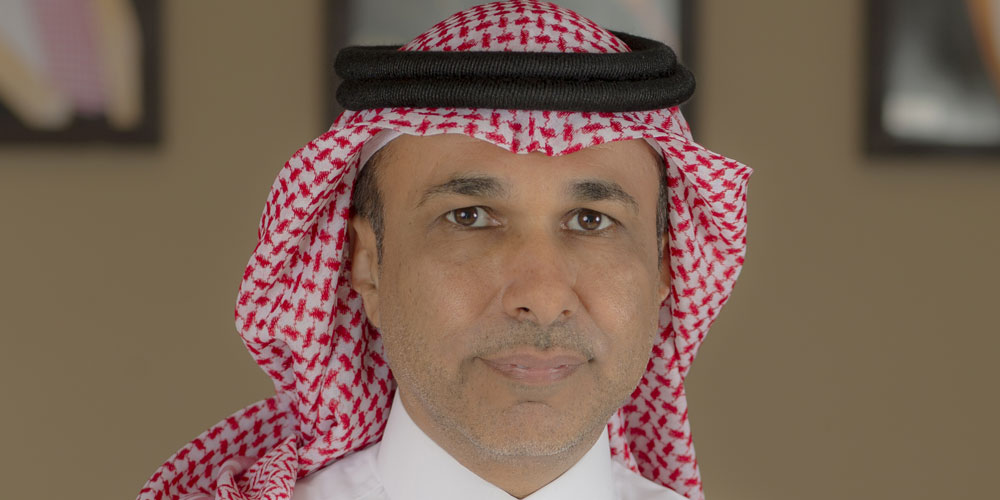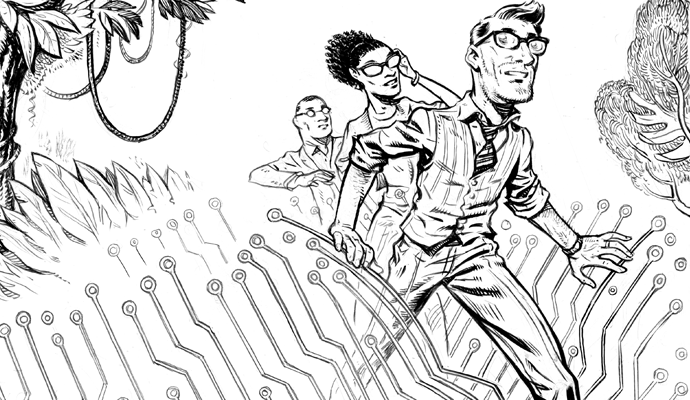The digital journey of stc
Group CEO Nasser Al-Nasser explains how the company’s digital strategy has helped it meet customers’ urgent needs and reveal new opportunities for growth.
This interview is part of the Inside the Mind of the CxO series, which explores a wide range of critical decisions faced by chief executives around the world.
In Saudi Arabia, any resident signing up for mobile phone service is probably doing so through stc, the preeminent provider in the country and a formidable player throughout the Middle East. Group CEO Nasser Bin Sulaiman Al-Nasser, who is stepping down in March 2021, has led the company through the pandemic, when traffic on the stc network suddenly increased far beyond precrisis forecasts. Demand for distance learning, for example, grew by up to 1,000 percent after the pandemic struck.
As Al-Nasser recently told strategy+business, he credits the company’s digitization strategy — known as DARE, for digitize stc, accelerate performance, reinvent experience, and expand scale and scope — with enabling the company to ramp up quickly. The DARE strategy (and its current iteration, DARE 2.0) encompasses both the technological and the cultural changes needed for digital transformation, and dovetails with the government’s goals of transitioning the country to a post-petroleum future. Accordingly, under Al-Nasser, stc has invested in a host of emerging technologies, including artificial intelligence (AI), the internet of things (IOT), and 5G. Along with its core mobile, fixed-line, and internet businesses, stc has expanded into mobile payments, telehealth, and other areas.
S+B: How has stc used its focus on embedding digital, agile ways of working, and analytics within the organization, to manage the challenges of COVID-19?
AL-NASSER: COVID-19 challenged the whole world on so many fronts: suffering and loss of lives, loss of businesses and jobs, the immense pressure on public health services, and the enormous impact on education. As a leading ICT [information and communications technology] company, we were able to play a role in supporting government efforts, business continuity, and the wider communities we serve.
The rapid shift to remote work [demand is up 567 percent], online education [up 1,000 percent], and remote health services [up 177 percent], and the drastic rise in e-commerce, exponentially increased traffic on our network infrastructure. This meant challenges related to network capacity, quality of service, remote operations, and the need to provide customer services and customer care via digital channels. stc provided access to its education and health platforms to customers for free during this difficult period.
Coping with challenges like these in a short period of time is a daunting task for any organization, but thanks to our DARE strategy, we were well positioned to deal with the crisis. We’ve been executing this strategy since 2018. Digital transformation of our operations and ways of working is a key pillar of the strategy, and enabled us to meet the new demand without compromising the high-quality experience and speed that our customers expect. For example, we have invested heavily in fiber and mobility infrastructure (4G and 5G) over the last three to four years, allowing us to quickly enhance capacity to meet the new demands and to seamlessly shift our customer interactions to safe digital channels.
S+B: What strategic changes, if any, is the company considering to take advantage of new opportunities brought about by the pandemic — for example, the increased adoption of telehealth services?
AL-NASSER: Along with the many challenges brought on by the pandemic, we do see several opportunities to serve our customers in new ways. That’s why we have increased our focus on technology infrastructure, digital services, customer experience, and accelerated digital transformation. As we look to DARE 2.0 — the next phase of our strategy — telehealth will be an important area of focus.
With an ICT network that spans the Kingdom of Saudi Arabia [KSA], stc has an opportunity to bring telehealth services to underserved rural areas, both improving the quality of care and lowering costs. We have partnered with Royal Philips, a global healthcare technology firm, to do so.
We will also be working to develop our internet of things capacity to provide advanced solutions for smart city applications, industrial automation, logistics, public services, and smart home applications. To support these efforts, we are increasing our investment in 5G deployment, virtualization, cloud, analytics, data centers, and emerging technologies such as AI and AR/VR [augmented reality/virtual reality].
We believe we have an essential role to play in providing the underlying technology infrastructure that enables digital services, such as telehealth, remote education, and other emerging services. We know that to realize these goals, partnerships in both the private and public sectors will be essential, so building these partnerships will also be a priority in DARE 2.0.
S+B: How has the pandemic affected the way you and the broader business community in Saudi Arabia view such low-probability, high-impact events? Are you considering any changes or initiatives to ensure stc is even more resilient to future crises?
AL-NASSER: The Middle East region has been arduously working with digital tools to combat the COVID-19 outbreak; the countries that were able to quickly adapt were those ones that had long realized the importance of technology advancements. Supported by a robust digital infrastructure, the business community has been agile, and we have seen a quick adaptation to changes and the new reality we face today. During the current circumstances, digitalization has provided us with great tools to virtually communicate, accomplish our work, or run our businesses.
In my view, [creating] initiatives to build agility in operations, and then adding in the business basics of strategy planning and execution, resource allocation, and decision-making, are all essential for weathering crises, including disruptive innovations, new technologies, cyber-threats, and geopolitical dilemmas.
We believe we have an essential role to play in providing the underlying technology infrastructure that enables digital services, such as telehealth, remote education, and other emerging services.”
It’s going to take time for businesses to recover from this shock. I think business leaders need to consider three steps as they prepare for a post-COVID era. First, we need to put digital transformation at the top of the agenda, with clearly defined and measurable short-term and long-term objectives. It’s important to communicate the message across the organization and to not complicate it, making clear each person’s role.
Second, as the COVID crisis has taught us, it pays to prepare early. Our world is getting increasingly complex, making global disasters more likely. We should take the time now to build the right technical and human capabilities as well as an organizational culture that facilitates digital transformation. For example, it’s important to build a dedicated, centralized platform for digital governance and execution that embraces the entire organization. This will ensure focus, continuity, and optimal value creation. At the same time, we have to make sure we have the right skills to execute. This is a major challenge that will require businesses to both develop existing staff and attract new digital talent.
Finally, we need to retain the lessons we’ve learned in the pandemic. For example, many organizations have seen productivity gains as a result of the flexible and digitally enabled work policies put in place over the last few months and should consider making flexible work environments and workforce policies the norm, even after the current crisis abates.
S+B: How will stc’s emerging technology strategy enable Saudi Arabia’s digital transformation and Saudi Vision 2030 reforms? What do you see as the greatest short-term and long-term opportunities your clients across sectors can benefit from in adopting emerging technologies?
AL-NASSER: One of the fundamental objectives of the KSA Vision 2030 is diversification of the economy away from oil dependence through digitization of industries, enterprises, public services, and consumer applications. To achieve this goal, the Kingdom needs a robust underlying technology infrastructure and well-developed digital services. With such an infrastructure in place, we can encourage development of digital services and capabilities across industries and even across the social aspects of life. This transformation will help to create a thriving and vibrant digital economy.
Telecoms are emerging as key enablers of digital economies, essential to transforming industries, businesses, and lifestyles. Emerging technologies, which are expected to represent more than 40 percent of new revenue growth in the technology sector until 2023, will be the fundamental building blocks of this journey. They will be not only enablers but key sources of strategic competitive advantage for stc. In our view, the most important of these emerging technologies are 5G, IoT, AR/VR, cloud, AI, robotics, and data analytics. We are already investing heavily in these areas and in related capabilities.
Our investment in stc pay, our fintech arm, is a good example. stc pay became the first unicorn in the Kingdom and the first fintech unicorn in the Middle East when Western Union acquired a 15 percent stake for US$200 million this past November. stc pay enables customers to transfer funds from an app on their mobile devices. With the Western Union partnership, users can now send money to more than 200 countries. This type of service is especially well suited to KSA, where 70 percent of the population is under the age of 30. By tapping into the rapidly growing popularity of smartphone and internet usage, stc pay has attracted more than 4.5 million users. That scale will help the government achieve its goal of reducing dependence on cash as it modernizes the economy. Meanwhile, stc pay is in talks with regulators to expand services into Bahrain, Kuwait, and the United Arab Emirates.
We are maintaining our technology leadership position in the region in other ways, as well. stc has connected more than 2 million households with high-quality fiber technology. We are also investing heavily in IoT use cases, cloud services, and data analytics capabilities — all strategic growth areas for stc. And all of which will continue enabling transformation of public services and industry applications such as utilities, transport and logistics, security, manufacturing, retail, health, and education.
Author profile:
- Jad Hajj is leader of the technology, media, and telecommunications practice in the Middle East for Strategy&, PwC’s strategy consulting group. Based in Dubai, he is a partner with Strategy& Middle East. He specializes in helping technology and telecom service providers develop winning strategies and build distinctive digital capabilities.





